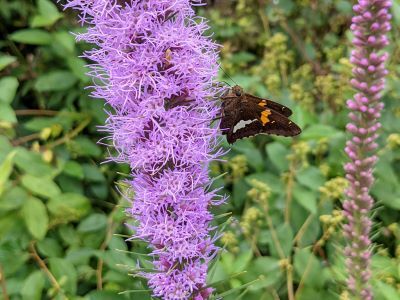
Good Natured: Benefits of Native Plants
When was the last time you had an A-ha! moment?
You know what I'm talking about. An abrupt realization that literally changes everything; a “Wait a minute!" dawning that causes you to see things in a different, often better, light.
I know I've had plenty, scattered over a wide variety of topics and an even greater number of years. There was the day back in 1965 when I received my first pair of pants with pockets. A-ha! Suddenly I could explore and collect stuff and keep both hands free. Fifty-eight years later and I'm still grateful for that epiphany.
But today's column isn't about me. It's about my friend and coworker Jill Voegtle, and a particular A-ha! experience she had a while back. It was a breakthrough, for sure—a day she'll never forget. But you know what's really cool about it? She's sharing it with all of us.
The other day Jill gave me the details about when she realized, after a lifetime of gardening and a career in horticulture, what a tremendous impact even a small amount of native plants can have on a landscape.
“I had planted a 25-foot long strip in the garden at my parents' house all in natives," she recalls. “I was standing there one day, looking at the plants, and I realized I was seeing things I'd never seen before."
Not the blooms—though they no doubt were stunning. Nope. What Jill witnessed then, and what she continues to promote today, is the astounding interconnectedness between native plants and native wildlife. Insects buzzing, birds flitting—a microcosm of our local ecology centered around a 25-ft. strip of land amid, ironically, lots of other carefully tended, but not native, plants.
“There I was, almost 30 years old, and seeing things for the first time," Jill says. “A black wasp on rattlesnake master—I'd never seen a bug like that before. It was a lightbulb moment for sure. Where would these animals go if these plants weren't here?"
I know lots of folks are less enamored of wasps and things but also fond of, say, birds and butterflies. The thing is, really, all life is linked together.
“If you want those pretty things in your yard then, ecologically speaking, planting natives is what you have to do," Jill says. “Take birds, for instance. What do they eat? What do they build their nests with? What do they feed their babies? Native plants give them everything they need."
Turfgrass, Jill adds, may be the standard for yards in our area but, in terms of what it gives back to the environment, it offers next to nothing. “You have to mow it, water it, feed it, and for what?" she says. “There's really nothing helpful that it attracts."
To underscore the importance of plant diversity, a few years ago Jill chose an area in our Hickory Knolls Natural Area that was 100% Hungarian brome, a once-common cover crop, and over the course of a summer changed it from a lifeless monoculture to a thriving community of prairie plants and pollinators. Wild quinine, little bluestem, prairie dropseed, whorled milkweed, prairie milkweed, foxglove beardtongue, sand coreopsis, rough blazing star and pale purple coneflower now fill the plot with an array of shapes, colors and textures. Native bees, honey bees, assorted flies and beetles swirl about too, feeding at the pollen-n-nectar oasis.
Similar transformations have occurred in natural areas throughout the park district. Where nonnative cattails and reed canary grass once dominated at Ferson Creek Fen, a diverse community of sedges and other moisture-loving plants create a welcoming environment for a wide variety of insects as well as birds, including American woodcocks and sandhill cranes. At Delnor Woods Park, woodland wildflowers proliferate where once only invasive buckthorn and garlic mustard grew.
If you're reading this and thinking, gee, I'd like to have a few A-ha! moments myself…well then, like they say on TV, have I got a deal for you!
Just two short weeks away, on June 3rd, our Hickory Knolls Discovery Center will be hosting its Fourth Annual Native Plant Sale. Running from 9am to 2pm, the event will offer dozens of species of native plants, all uniquely adapted to growing in northern Illinois; in addition our naturalist staff, including Jill, will be on hand to answer your questions with regard to specific growing conditions.
Whether you're looking for plants that need sun or shade, dry soil or moist, we'll help you find what you need to create A-ha! moments of your very own.
Pam Otto is the outreach ambassador for the St. Charles Park District. She can be reached at potto@stcparks.org.

